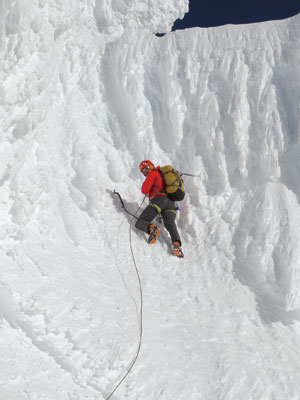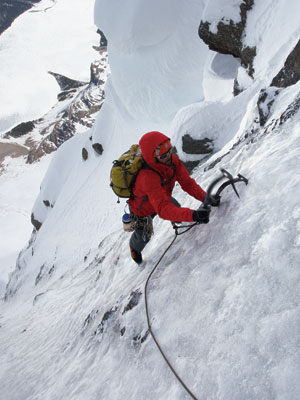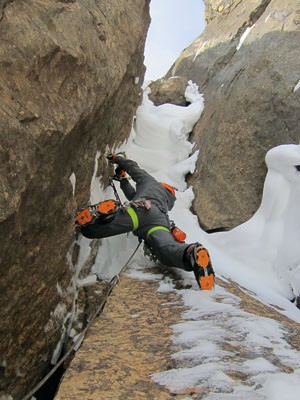Canadian Rockies Lessons – From Novice to Intermediate
In 2011, I decided I wanted to experience a new place and to explore some of the Rockies' lengendary peaks and climbs. Unfortunately, I had no idea what I was in for. The Rockies werer bigger and badder then I expected.

The following is an article by Josh Wharton that was published in Gripped in 2012 titled “Canadian Rockies Lessons – From Novice to Intermediate.”
The Rockies aren’t sexy, at least not within American climbing circles. They’re mostly known for waterfall ice climbing and choss. Neither of which inspire terms of endearment. American alpinists are mostly drawn to Alaska, South America and eventually Asia, content to torque their picks into solid granite and take desperate breaths at high altitude.
For the last 15 years, I was guilty of taking the same approach. I hadn’t even considered an alpine climbing trip to the Rockies. Instead I’d followed the well-trodden path to Patagonia and Pakistan, with an occasional foray to Alaska, or elsewhere. But in 2011 I decided I wanted to experience a new place and to explore some of the Rockies’ legendary peaks and climbs.
Unfortunately I had no idea what I was in for. The Rockies were bigger and badder then I expected. On my first trip, in May of 2011, my partner and I spent twelve hours plunge stepping (on skis), over Woolley Shoulder to the base of North Twin, just to turn around amidst snow squalls and ski right back to the car. We salvaged the trip by climbing the Andromeda Strain, but it felt less then fulfilling. In September, I hiked over Woolley Shoulder again, but this time everything was plastered with half a meter of fresh snow. Our free climbing hopes for the Twin looked very unlikely. With all the consolation prizes similarly out of condition, we waddled back to the car with our tails between our legs and settled for some quality sport pitches at Acephale. In December I spent a week shivering through pre-dawn approaches, and after dusk descents, mostly at the Stanley Headwall, realized that December was most definitely not the time for climbing big alpine routes in the Rockies.
Although I’d climbed on every trip, none felt like a success and I was beginning to come to terms with what it would take to climb something big in the Rockies. I learned the peaks were finicky and it was necessary to spend several weeks in the area to have a real shot at the right combination of weather and conditions. I realized there were no easy sources for beta. There simply aren’t many active Rockies alpinists, and those that are, aren’t given to jaw flapping or frequent blog posts. Jon Walsh told me he thought there might be 30 truly active climbers in the entire range. With so few climbers, I noticed that routes took on legendary status based upon only one or two ascents and few if any repeat attempts. It was an easy place to be scared off by climbs with a big scary “bark”, but perhaps a less severe “bite.” And finally, I learned that a Rockies alpine climbing trip actually entailed lots of climbing. Unlike Alaska and Pakistan, in the Rockies sport climbing and good “Yam days” were plentiful, and with the comforts of Canmore nearby, there was no reason to hunker into a miserable tent while waiting for the alpine stars to align.

Despite all this, I was still a Rockies novice, but at least I had a handle on what the Range required. So in May 2012, I set up base in Canmore, comfortable in an affordable rental, somewhat broke by expensive groceries and pleasantly sore from a steady dose of sport climbing at The Lookout.
Monday, May 7, 2012
I’m partner-less at the beginning of a good weather window. I send emails to everyone and their friends, without much luck. Lesson number nine–by May, most Canadians can’t even look at an ice tool, let alone consider swinging one next to a Yankee newbie. Fortunately a fit partner is sitting right in front of me.
My fellow Coloradoan, and good friend Chris Alstrin is in Canmore shooting a movie about ski mountaineering. Chris hasn’t climbed in months, but routinely puts in 100 mile-plus efforts on his bike. After a bit of cajoling I talk him into trying The Wild Thing VI 5.9 A3 WI4. We leave the car at 4 p.m. to negotiate the isothermic snow and foreign approach in the light. Two hours later we make a comfortable bivouac 100 metres from the base of the climb.
Tuesday, May 8, 2012
I can’t sleep, and instead listen for wet slides. The night seems still and no major avalanches flush down the lower portion of the route. I’m up before the alarm goes off at 1 a.m. We have a quick brew and ditch all the bivy gear apart from a Jetboil and a tiny tarp. The first 700 metres of the route goes in two pitches. We benefit immensely from spring snow, which makes the technical steps in the lower portion of the route short. There’s not much in the way of gear, so Chris jumps right into some serious simul-climbing. I apologize for the lack of anchors.
The legendary A3 pitch is unbelievably cool: a thin, slightly overhanging crack on the left wall of a wide chimney with no choss in sight. The crux is locking off long enough to clear away snow mushrooms and root out the next pick placement. For the next 30 ft I’m glad I spent some time at The Lookout. Over cocktails in Canmore a week later, Barry Blanchard tells me stories about the whipper-laden fight this pitch put up on the first ascent. Lesson number 18: sometimes it’s best not to know a route’s history before you attempt it.

The upper chimney is as aesthetic as any I’ve ever climbed on a big alpine route. Diamond hard alpine ice requires five swings per stick and the soles of my feet start to ache with all the kicking. The last five metres, ordinarily climbed by burrowing under a chockstone, are completely blocked by cornices and mushrooms. With some serious burrowing and cursing I engineer my way upward and 15.5 hours after starting Chris and I top-out right next to the summit. We exchange a solid exploding fist bump.
Wednesday, May 9, 2012 sometime after 1 a.m.
Rockies lesson number 26: bring fire retardant technical climbing clothing. The supposed four to six hour descent is epic. Lake Chephren is half a metre deep with slush and Chris and I completely soak and freeze our feet before stepping off the edge of the lake and plunging up to our hips in snow. We spend two hours in a tree well trying to dry our feet by a smoky fire. We start up again at 3 a.m., but give up after I lead us in a circle through the trees. Another fire, and a fitful attempt at sleep due to blowing embers, and finally at first light we posthole miserably back to the van, arriving at 8 a.m. The descent takes as long as the climb.
Thursday, May 10, 2012
Before the climb, I promise Chris I’ll retrieve our gear from the base of the route, so despite being exhausted I drive up from Canmore solo. Fortunately I’ve already learned lesson number 34: the Rockies require extra floatation. My second pair of skis help me get back to the base relatively easily and the heavily loaded (bivy gear, ski boots and two pairs of skis) ski out is intense ans punctuated a comical series of falls. This would make good footage for Chris’ ski film.
Friday, May 11, 2012
Jon Walsh has been a personal hero since I met him in Patagonia several years ago. He’s psyched, tough and talented, and always seems to be doing something interesting in the climbing world. He meets me in Canmore at 3 p.m. and we drive north for Robson’s Emperor Face to catch a $700 heli ride to Berg Lake at 9 p.m. Jon has already paid his dues doing the 25 km approach slog several times. He also has to be back for work on Monday. My tired legs aren’t complaining one bit. Rockies lesson number 49: don’t sweat a few hundred bucks, when it might save you years of attempts and a few thousand dollars in the long run.

Saturday, May 12, 2012
We huddle together under a thin tarp until 3 a.m. and then set off. The entire Emperor Face is covered in fresh spring ice. It looks as if you could climb anywhere-new lines for generations to come, or at least repeats of long forgotten ones. We choose Infinite Patience VI 5.9 M5 WI5, mostly intent on getting to the top of the mountain quickly and efficiently. Again the route is anything but choss. It’s continuous one-stick hero ice, gorgeous neve and only the occasional stretch of powder-snow plodding. There are bits of technical climbing, but really the route is a physical and mental challenge. Robson is a little slice of the Himalaya.
Lesson number 57: if you’re lucky enough to have a rare Rockies topo, pay attention to it. On the 800 metre traverse Jon and I grow impatient, ignore Pellet’s excellent topo, and start towards the summit gargoyles too soon. More than 3000 metres of relief between the summit and Kinney lake forms powerful updrafts. I zig and zag amongst unprotectable rime ice, clearly off-route, and eventually find the summit. It feels like I’ve been transported to Patagonia. The route takes 18 hours, but there’s still a long unknown descent in front of us.
Sunday, May 13, 2012 sometime after 2 a.m.
It feels like we’ve been down-climbing easy, but serious no-fall terrain for hours, and most of it in big slide paths under clearly active seracs. To describe the direct descent down the south face as “tricky” is starting to feel like an understatement. We search for the hut we have dreamed of finding for hours to no avail. We finally give up and lay down in the snow with the tarp over us. At first light we wander downward again, finally dropping into the wet slide laden Grand Central Couloir. At noon we reach the car. An unknown kind soul has left a beer sitting on the windshield. Lesson number 62: rumble strips are key to the longevity of Canadian Alpinists. Jon arrives home with enough time for a good night’s sleep before work on Monday.
Tuesday, May 15, 2012
Mikey Schaefer, Dylan Johnson, and I set off for the Greenwood-Locke V 5.8 A2 on Mount Temple sometime early in the afternoon. Mikey is here to shoot some “authentic” alpine climbing for Patagonia. The north face of Temple is probably a bit of a stretch for a photo-op, but Dylan and I are too selfish to waste good weather on an easier route better suited to posing. We barely make it to an amazing bivouac perch before dark. 100 metres above the top of the Dolphin, and with the lights of Lake Louise stretched out below, Mikey captures some phenomenal images. Lesson number 77: it’s possible to actually get real-deal alpine climbing photos, but only with a photographer that is also a badass climber.

Wednesday, May 16, 2011
I’d be lying if I said I wasn’t beginning to feel a bit strung out. I’m tired and my feet hurt so much that I dread kicking steps. Fortunately the Greenwood-Locke is technical and keeps us on our toes. Each pitch requires attention to detail and there are some serious sections of climbing for both the leader and seconds. Unlike Robson and Chephren, choss is abundant, particularly where big snow mushrooms push you off the summer rock line. Mikey continues to rip off the photos while Dylan and I take turns pushing the rope upwards. We find Steve House’s crampons and a bunch of tat halfway up the headwall, a spooky reminder of his near fatal accident just two years ago. Lesson number 89: you can never truly master the Rockies. Spend enough time here and something’s bound to give.
The last week has made me downright paranoid about Rockies descents. I almost dread the top-out and rightfully so since I exit into a bone-chilling snow squall. But as if by some miracle and to my great relief, Dylan finds a decent down some sneaky gullies and we only posthole once or twice before reaching our skis at Lake Annette. We chase bear tracks out to the car. Dylan and Mikey scream “Hey Bear!” often. I mostly ski in silence, so exhausted that being a Grizzly’s snack sounds somewhat more appealing than skiing another kilometre.
The next day I sleep until noon and don’t even check the forecast. For now I’m satisfied. The Rockies have taught me well and I know there are many more lessons and adventures to come. I’ll be back next year, probably just to sport climb, but with a little luck maybe the Rockies alpine school will be in session again.
– Josh Wharton is an American climber who understands the attraction to the Canadian Rockies.


